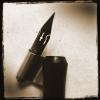Search the Community
Showing results for tags 'history'.
-
I bought a set of 6 of these pens on eBay 4-5 years ago, all for under $50. They came in 6 different colors, if I recall correctly. I gave 5 of them away, and stuck this last one in the drawer. Inked it today, and was surprised at how great it writes. Obviously a steel nib (F), plastic parts everywhere else, but a genuine Waterman nonetheless. Good medium size, light feel, a lot of fun to write with, and it accepts the Waterman converter so you can use any kind of ink. Does anyone have any history on this? I can find nothing on any Internet search. Another name it may go by? I'd love to pick up more, and give 'em out to friends, if I could still pick 'em up for under $10 apiece. Thanks!
- 6 replies
-
- inexpensive
- history
-
(and 1 more)
Tagged with:
-

"the Golden Thread – The Story Of Writing" – New Book By Ewan Clayton
Estefa posted a topic in Calligraphy Discussions
"We are at one of those turning points, for the written word, that come only rarely in human history. We are witnessing the introduction of new writing tools and media. It has only happened twice before as far as the Roman alphabet is concerned – once in a process that was several centuries long when papyrus scrolls gave way to vellum books in late antiquity, and again when Gutenberg invented printing using movable type and change swept over Europe in the course of just one generation […]. Changing times now mean that for a brief period many of the conventions that surround the written word appear fluid; we are free to re-imagine the quality of the relationship we will make with writing, and shape new technologies. How will our choices be informed - how much do we know about the medium's past? What work does writing do for us? What writing tools do we need? Perhaps the first step towards answering these questions is to learn something of how writing got to be the way it is." I am quoting here the introduction to a book I am very much looking forward to read: "The golden thread" by Ewan Clayton. It sounds so promising and interesting, just about two things I hold very dear - (the history of) reading and writing, written from the perspective of both a calligrapher and designer. So far I just managed to read about 40 pages and it is packed with information and ideas. You can find a short review here on the website of the FT http://www.ft.com/intl/cms/s/2/c36c371e-3006-11e3-9eec-00144feab7de.html#axzz2hsO9lNXP and more about the author here http://www.ft.com/intl/cms/s/2/4240f110-1a04-11e3-93e8-00144feab7de.html#slide0 I thought maybe some of you may be interested as well. Stefanie (I hope this is the right forum, I wasn't sure. But I didn't put it in the book section because it is not "only" about calligraphy – but if it should be moved there I am totally ok with that )- 6 replies
-
- calligraphy
- western
-
(and 3 more)
Tagged with:
-
I found the following history of Chelpark company in a website. Hope you will find it interesting *made small formatting changes to make it easier to read =========================================================== CHELPARK COMPANY PVT LTD. The Parker Pen Company, manufacturers of ink, was in partnership with a company in south India by the name of TTK. But Parker wanted to find a new partner in India, as they did not wish to continue their association with TTK. That's when Mr. Byford the main advisor to the Parker family approached the Chellaram family to become their partners for India. Mr. Byford and the Chellaram family had an old association, as the Chellaram family were large buyers of Parker products for trade in the west African region. The Chellaram family discussed with Mr. Byford that they were willing to buy the majority of shares of the Parker operation in India but on a condition. The condition being that the Chellaram family would not be involved in the day to day running and administration of the company. And only Parker would run the entire operations. Parker agreed to this condition laid down by the Chellaram family and they both officially joined hands for the India operations. After giving it some thought it was decided that "Quink" had to be given an Indian identity for it to appeal to the Indian consumer. This is when the brand name Chelpark came into being signifying the Chellaram and Parker. This change in name was backed by an advertising campaign in which showed the peeling off of the Parker sticker and a new sticker that read "Chelpark" on it appearing. This ad campaign was an instant hit and that was the birth of this famous company called Chelpark. The first official name of the company after the Chellaram family bought the majority shares was Chelpark Company Limited. Which was changed in 1985 to Chelpark Company Private Limited. And the head office was shifted from Madras (now known as Chennai), Tamilnadu to Bangalore, Karnataka. This long standing partnership of the two business families came to an end around 1968/69 due to the changes in the Indian finance ministry policies. It was not profitable for Parker to continue its operations in India and therefore decided to sell off their entire shareholdings. This is when Chelpark which was initially only known for its fountain pen ink started diversifying into other office stationary products and today it has become a household name in India with its wide product range.
-
Hello all, I currently live at the old Wahl/Eversharp factory building (which is now a condo building) at 1800 W. Roscoe Street in Chicago. I am working together with an active group of volunteers in researching the history of Wahl/Eversharp. Our goal is to commemorate the history of the company and the people who made-up the company. We are planning to feature photographs, artwork, and displays throughout the building and are planning centennial celebration to celebrate the 100 year anniversary of the building. We have already identified some amazing photographs (which we are getting permission to use) of the construction of the factory building, almost 100 years ago. The photographs show the building being constructed using horses and wagons. We also have a photograph, which shows the bakery next to the factory. We believe this is the bakery which provided food for the striking factory workers. I would love to reach out to ANYONE who has a deeper understanding of the history of the company, the people and or the building and would love to connect with anyone who has a personal connection to building. Regards, Michael
- 10 replies
-
- wahl-eversharp history
- 1800 w. roscoe
-
(and 3 more)
Tagged with:
-
Last winter I wrote an article about the Gimborn firm. It was published in the journal of the Writers Equipment Society this spring. You can find the article here. I hope you'll appreciate it. Allard Borst.
-
Hello, pen historians. I’m writing a fiction story, and I’m hoping you can help me out with a few period details because while I love the modern pens I have, my knowledge of vintage is practically nil. What uniform-rules-compliant pen is the most likely choice for a very poor US soldier to have purchased in 1943? I’ve read up a bit on pens with military clips, but am still rather unclear regarding the prices as they would have stood then. Any recommendations you folks have would be a big help. So, again: inexpensive pen with military clip available for purchase by US servicemen in 1943. What am I? Thank you, ~DorothyNotGale PS: Also, information on where to go to learn about likely inks and the performance of the hypothetical pen for sketching as well as writing purposes would be appreciated.
- 59 replies
-
Hi all, I've been thinking about how different nib sizes came about. I'm relatively new to fountain pens, but have seen the huge variety of nibs available to tailor to each persons hand. Out of curiosity I must ask. If manifold nibs and flexible nibs were born out of a need or necessity for practical purposes (which for the above I understand to be primarily accountancy and legal documents respectively), then how did the bold nib come about? I know it's an unusual question, and in current times it's all about preference but who came up with the idea of a big fat line and why? The only practical application that I can think of would be for use in signatures. Was there some common purpose or reason that meant that historically if you could only afford one fountain pen you'd be advised to carry a bold nib? Hope this question makes sense and thanks in advance, Badger
-
Hi, me again! Now, next year, I'll be taking five modules of History and a German module at University. My question is... what inks do these modules make you think of? Public History (How History is perceived by the public) - my first thought was brown. Probably an indication of how dull it sounds! Piracy and Privateering - might use my Waterman's Green for this. Thinking About the Past - purple, possibly? TBA TBA German - Red?











